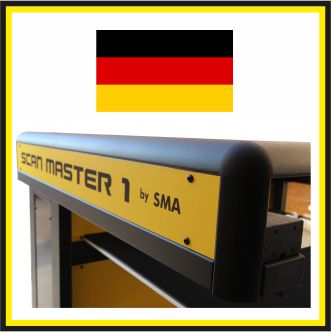At the beginning of the year 2018 a SMA SCAN MASTER 1 was installed at the Service-Center Digitization and Photo Documentation (SDF) of the Johannes Gutenberg University Library (JGU) Mainz. The decision for this system which should replace an old ProServ book scanner was influenced by several different parameters: Longevity, productivity, flexibility and capability. The main goal was to achieve the highest quality scans to meet the DFG-Practice rules for digitization for all research and teaching materials at the JGU. These conditions were not only met but exceeded by the SCAN MASTER 1.
During the installation at the SDF it was beneficial that the SCAN MASTER 1 was completely flexible in regards to placement and operation. The wheels not only allowed for easy initial placement but also the flexibility to readjust the work environment as needed.
Since the scanner is located in a north facing office that is used under typical daylight conditions, it was a major advantage that the SMA SCAN MASTER 1 is able to operate independent from ambient light. This advantage not only sets the SMA SCAN MASTER 1 apart from all competitive products but also creates a more favorable working environment to the end user.
With its robust state-of-the-art design, the SCAN MASTER 1 has a sleek, sturdy and compact look and feel. The acrylic glass cover not only offers protection by prohibiting the user from unintentionally touching the moving scan head but it also offers a convenient work area for future scan materials.
Unlike the ProServ book scanner, the SMA SCAN MASTER 1 also includes a pull-out book cradle for convenient initial placement of all originals.
The first project with the SCAN MASTER 1 is the digitization of LP records. To protect the original, the LP records cannot come in contact with the glass plate to avoid any unnecessary pressure. To accomplish this, the scanner is equipped with a special light barrier that detects the original and stops the book cradle just before it reaches the glass plate.
Another notable advantage of the SCAN MASTER 1 is its visual 3D capability. This is a very unique feature that is not typically found in book scanning technology. The SMA SCAN MASTER 1 utilizes angled light elements that can be controlled separately to capture structural surfaces, creating a visual 3D image.
In regard to the plans of capturing objects, the SMA SCAN MASTER 1 offers significant advantages for future SDF digitization projects. SDF projects include scanning of embossed material, print graphics, coins, printing plates, fabrics and organic material such as leafs etc.
The scan application software is user-friendly and available in different languages.
Conclusion: The SMA SCAN MASTER 1 is an outstanding replacement for the old scan station. It offers the SDF a broader spectrum of capturing capabilities without compromising quality or the working ergonomics.



